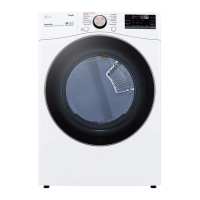
Do you have a question about the LG DLGX4001 Series and is the answer not in the manual?
Describes the cycle selector knob and touch controls for easy operation.
Details the wide-opening door and its reversible hinge for installation flexibility.
Explains LG's steam technology for refreshing clothes, reducing static, and easing ironing.
Sensing system that detects and alerts to restrictions in the dryer ductwork.
Feature for transmitting diagnostic data to a call center for quick issue analysis.
Smart phone app for setting options, self-diagnosing, and troubleshooting the appliance.
Covers reading instructions, understanding warning symbols, and specific fire/explosion hazards.
Guidelines for safe installation, including electrical, grounding, and handling precautions.
Diagram and labels for key components of the dryer.
Lists and illustrates accessories that come with the dryer and those available for purchase.
Step-by-step installation guide and detailed product specifications.
Specifies requirements for choosing a proper location for the dryer.
Details recommended clearances for installation, including closet and cabinet spacing.
Instructions on how to properly level the dryer for optimal performance and stability.
Step-by-step guide on how to change the dryer door swing direction.
Instructions for installing side and bottom vent kits for proper dryer exhaust.
Guidance on safely stacking the dryer, typically on top of a washing machine.
Critical information on proper dryer venting, including ductwork requirements and limitations.
Guidelines for maximizing drying performance and reducing lint buildup in ductwork.
Instructions for connecting the cold water supply hose for steam-enabled models.
Details on electrical and gas supply requirements for connecting gas dryers.
Considerations for installing gas dryers at high altitudes.
Specific electrical requirements and connection procedures for electric dryers.
Instructions for four-wire power cord, direct wire, and three-wire power cord connections.
Specific electrical requirements for mobile or manufactured homes.
Tests to confirm proper operation after installation, including heating, airflow, and levelness.
Procedure to test exhaust system adequacy using the Flow Sense™ system.
Guidance on checking ductwork and troubleshooting common error codes.
Basic steps for operating the dryer, from cleaning the lint filter to starting a cycle.
Guidance on checking pockets, sorting laundry, and loading the dryer properly.
Overview of the dryer's control panel, buttons, and display elements.
Explanation of various indicators on the dryer's display panel, like AI Sensor and Control Lock.
Details on Sensor Dry and Manual Dry cycles, including fabric types and settings.
Information on adjusting cycle settings like Dry Level, Temp, Wrinkle Care, and Energy Saver.
Details on functions like Control Lock, Drum Light, and Steam Functions.
Explanation of steam options like Reduce Static and how to add steam to standard cycles.
Guide to connecting the appliance to a smartphone via the LG ThinQ app.
Overview of features available through the ThinQ app, including remote start and cycle downloads.
Instructions for remotely controlling the appliance and checking cycle status via smartphone.
Technical specifications for wireless modules and FCC compliance statements.
How to use the Smart Diagnosis feature for troubleshooting issues remotely.
Instructions for cleaning the dryer's exterior, interior, and areas around it.
Recommendations for checking and cleaning dryer vent ductwork to ensure proper airflow.
Steps for cleaning the lint filter, emphasizing its importance for drying performance.
Answers to common questions about dryer operation and potential issues.
Information on accessing video tutorials for further assistance.
Checklist of common problems and solutions before contacting customer support.
Specific solutions for issues related to steam cycles and functions.
List of error codes displayed by the dryer and their corresponding causes and solutions.
Details on warranty periods, scope of coverage, and how service is handled.
List of conditions and situations not covered by the limited warranty.
Information on arbitration, class action waivers, and dispute resolution processes.
